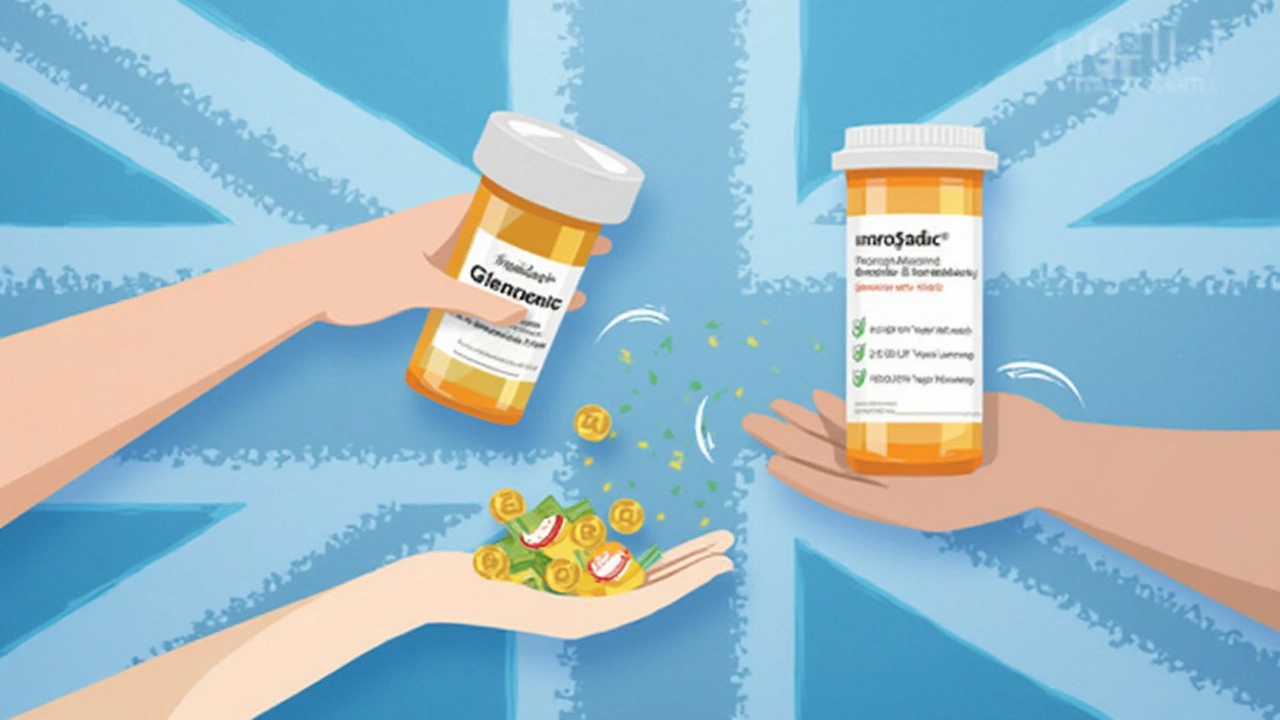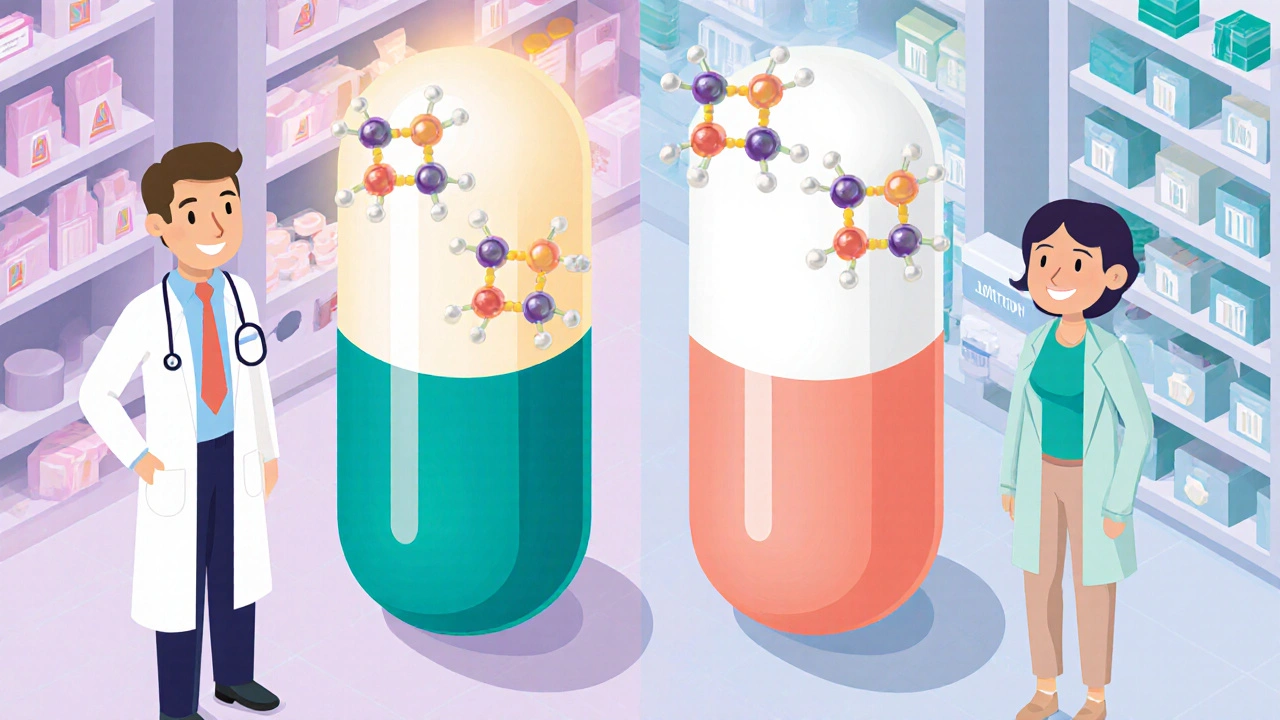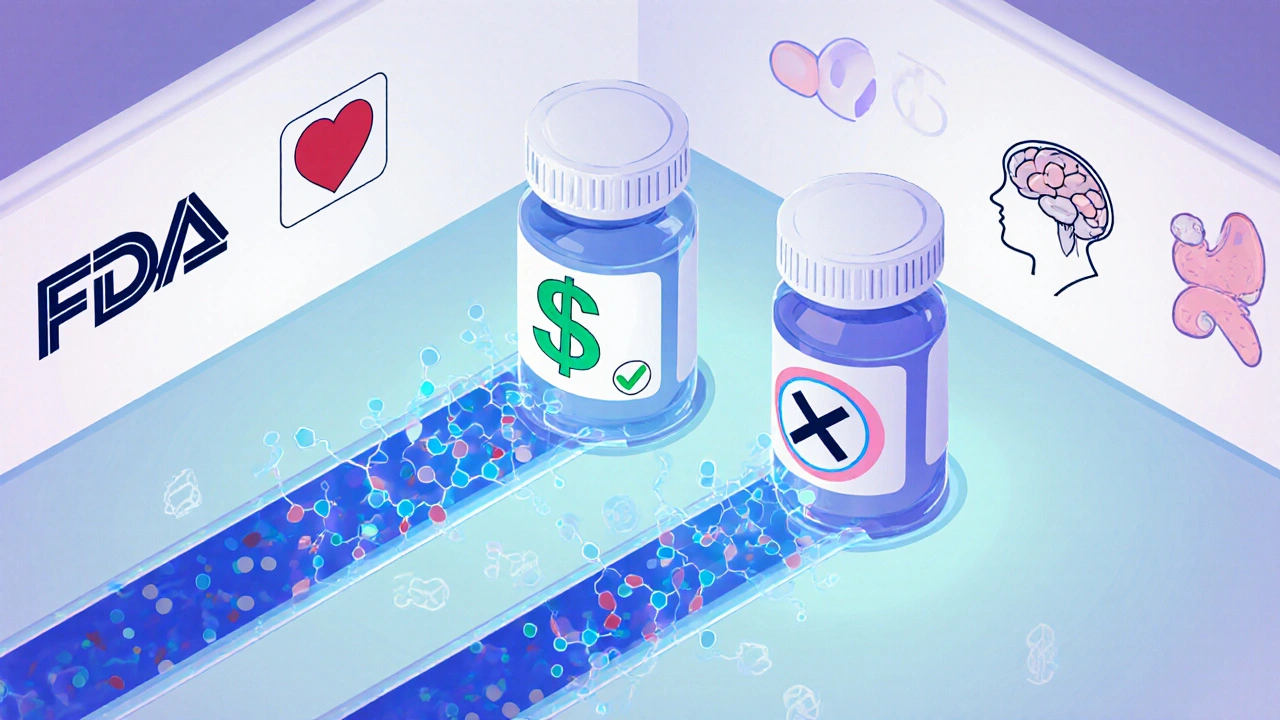Breaking Down Generic Drugs: What Makes Them a Game-Changer?
Here’s a wild stat: in the U.S., about 9 out of every 10 prescriptions filled are for generic drugs. So why do so many folks swear by them for chronic conditions? Generics take the original, branded drugs and copy the key chemical elements, delivering the same medicinal punch—just for a fraction of the price. But cheap doesn’t mean cut corners.
Let’s kill the biggest myth right away: generic doesn’t mean inferior. The FDA and health agencies worldwide lay down strict rules before a generic ever hits your pharmacy shelf. Every generic needs to match the original drug (known as a brand or "reference product") in critical ways: the active ingredient, the dosage, the strength, and how it enters your bloodstream. If you’ve seen the word "bioequivalence," that’s just a fancy way of saying the generic acts in your body almost exactly like the brand-name drug.
Imagine someone who’s been on metformin for type 2 diabetes for years. Brand-name metformin and its generic match up so closely in performance and blood levels that switching between them is almost undetectable—except in your wallet. That’s true for meds like statins (for cholesterol), SSRIs (for depression), or doctors’ favorites like losartan for high blood pressure. Manufacturers replicate these drugs, but skip the sky-high launch costs paid by the original inventor. The competition gets fierce, and prices dive.
Bioequivalence is actually measured using strict tests. Studies compare how much drug gets absorbed and how fast, in dozens of healthy volunteers. There can’t be much difference—usually within 80% to 125% tolerances for what’s seen in your blood, something only noticeable under lab conditions. No one can claim a generic works slower or gets broken down weirdly if it passes this bar. It’s what makes your $4 bottle of generic simvastatin work just like that $70 brand-name version.
The kicker? There’s often eye-watering savings for chronic users. Need an example? In 2023 alone, American patients saved around $383 billion just by switching to generics—much of that tied to long-term meds. And the impact is global: India's generics powerhouse has driven HIV drug prices down by over 90% for developing countries since the early 2000s. Real people get real relief not just from symptoms, but from sky-high costs every month.
Approval Roadmap: How Generics Make the Big Leagues
So, how does a generic leap through all the hoops? The path to approval is built on trust — but also piles of paperwork and science. Drug agencies like the FDA and the European Medicines Agency set concrete requirements. The biggest one? Proof a generic drug is bioequivalent to its reference product. But there’s more: manufacturers must show their labs, facilities, and quality control are up to scratch, too.
A generic’s active ingredient—what actually treats your condition—must be an exact replica of the brand’s. It goes through an “Abbreviated New Drug Application,” or ANDA for pharma nerds. Here, the company typically doesn’t need to run massive, years-long clinical trials on thousands of people, like the original inventors did. Instead, the generic makers show data from bioequivalence studies and prove their pills aren’t contaminated, crumbling, or unstable from batch to batch.
For chronic conditions, consistency is huge. You don’t want your asthma, blood pressure, or mood disorder meds to act different from refill to refill. Approvals only happen if the generics deliver the same punch every time, backing it up with testing for things like dissolution (how fast a pill breaks down), uniformity, and absence of weird impurities. It’s not just a rubber stamp; sometimes, even minor tweaks—like a harmless dye or new filler—require new scrutiny.
Safety systems don’t shut down after approval. Regulators keep checking in, inspecting facilities and reviewing patient side effect reports. That’s why a generic that passes the first round can still be pulled if quality slips. For rare, narrow-therapeutic-index drugs — think anti-seizure meds or thyroid hormone — companies often need fancier studies to confirm generics really match the original in even the tiniest detail.
But what about drugs that don’t quite fit the typical pill or capsule mold? For inhalers, patches, or self-injectables, approvals are even tougher. Companies must run extra studies on how the device delivers the drug (think insulin pens) and whether deep-inhaled generics actually deposit just as much medication in the lungs. For biologics—enormous, complex protein drugs used for conditions like rheumatoid arthritis—regulatory agencies use the term “biosimilar” because they aren’t exact knockoffs, but are clinically equivalent in their effects for most patients. It’s complicated, but the goal remains: lower costs, no surprises.

The Financial Impact: Projecting Patient and System Savings
If you’re living with a chronic illness, the math of medication costs isn’t just interesting—it’s personal. Just swapping a branded medication for a generic drug can trim hundreds, even thousands, off your yearly medical bills. Here’s a little context: The U.S. spends more on prescription meds per person than any country on earth, often because of brand-name pricing. Generics have been one treasure chest of relief—especially given how many chronic conditions require lifelong treatment.
Check this out: a recent JAMA study found typical out-of-pocket savings for patients switching to generics ranged from 60% to 90%, especially for drugs where multiple copies are on the market. If you’re on long-term statins for heart health, that saving might mean shelling out $10 or less per month, versus $200 for a big-name statin that works the exact same way. Even complex medications like antiretrovirals for HIV now have generic options that have slashed prices over 80% in less than a decade.
At the healthcare system level, things get even more dramatic. Generic competition puts pressure on manufacturers, which crushes the average price for everyone. Hospitals, insurers, and government programs can shift budgets away from expensive branded deals and focus resources on patient care, research, or preventive outreach. That ripple effect is why many governments, from the U.K. to Australia, actively promote generic substitution at the pharmacy counter.
But sometimes, it’s not just about pharmacy savings—it’s about the broader economy. When people can afford their meds, they’re less likely to skip doses or land in the ER with uncontrolled symptoms. Fewer hospitalizations and complications mean governments spend less mopping up the expensive fallout from untreated diabetes, hypertension, or asthma. Plus, more affordable medications make it easier for people without insurance—or with high-deductible plans—to actually finish their prescribed course.
| Drug Category | Brand Cost/Month | Generic Cost/Month | Annual Savings |
|---|---|---|---|
| Statins | $120 | $8 | $1,344 |
| SSRIs | $85 | $6 | $948 |
| Metformin | $60 | $4 | $672 |
The savings aren’t just marketing hype—they’re concrete, year after year. And the more generic versions that enter the market, the lower prices go. So, if you’re looking for alternatives, plenty of legit options are now becoming cheaper than RXConnected. It pays—literally—to shop around for your meds, especially for those you’ll need for the long haul.
Smart Tips and Insider Facts for Getting the Most from Generics
If you’re thinking of making the switch to a generic drug, here are a few things to boost confidence and squeeze the most value:
- Treat generics like brand drugs for chronic illnesses—because the active ingredient, effect, and safety are basically the same, by law.
- Don’t get tripped up by changes in pill color, shape, or packaging. That’s just a different manufacturer’s trademark—your body doesn’t know the difference.
- If you have allergies to certain dyes, ask your pharmacist which generic brands might avoid those fillers—you often have some choice.
- Check with your insurance about “formulary” status. Most plans will push generics, but some specialty or high-deductible plans have quirky rules. Get your doctor to specify “generic Okay” on the script where possible.
- Generic price swings sometimes happen after one company gets approved. If your monthly copay jumps, ask your pharmacist—they may be able to swap to another generic supplier or recommend cost-saving coupons.
Did you know some pharmacies set up their own discount savings clubs for generics? If you use multiple prescriptions for a chronic condition, ask about these programs. You could score even deeper discounts compared to using insurance for low-cost generics.
Finally, if you notice a rare side effect when switching from a brand to generic, tell your pharmacist and doctor right away. While problems are rare, reporting these cases helps keep the system honest—and sometimes leads to a quick fix by switching between generic refiners. And if you’re not happy with mail-order prices, just compare a few local options or search for verified pharmacy rankings—prices can swing more than you’d expect.
Living with a long-term illness is tough enough without your wallet taking a beating. Generics make it possible to actually stick with your regimen, avoid skipped doses, and keep your future bright. Whether you’re newly diagnosed or just tired of spiraling drug bills, the world of generics isn’t just growing—it's leveling the playing field.




Nilesh Barandwal
July 18, 2025 AT 00:40This article beautifully highlights the often overlooked but fundamentally crucial role of generic drugs! 🌟 It's astounding how these cost-effective alternatives alleviate financial burdens for countless patients enduring chronic illnesses—truly a beacon of hope!!
One cannot emphasize enough the importance of the rigorous bioequivalence standards that these generics meet, ensuring safety and efficacy stand shoulder to shoulder with their brand-name counterparts..
Moreover, the approval process is a marvel of healthcare efficiency, balancing speed and stringent checks to get affordable medication to those who need it most!!!
I especially appreciate the real-world savings examples presented here; seeing actual numbers paints a clearer picture of generics in action and their impact on the healthcare system's sustainability.
Does anyone know if there's ongoing research to further streamline this approval process without compromising safety? It's fascinating to imagine the potential economic ripple effects!
LEE DM
July 18, 2025 AT 01:40I agree, this post sheds light on a highly important subject not discussed enough, especially here in the US where drug prices can be astronomical.
Generic drugs offer an inclusive path forward, allowing a broader spectrum of people access to essential medications without the stigma or stress of crippling costs.
One aspect I found especially encouraging is the detailed explanation of bioequivalence — it reassures patients that generics are held to strict standards, which helps dismantle common misconceptions.
This knowledge empowers us all to make more informed health decisions and advocate for wider generic drug use as a cost-saving measure.
Has anyone experienced noticeable differences—good or bad—when switching from a brand-name drug to its generic version? I’d be curious to hear personal stories or insights.
Amy Aims
July 18, 2025 AT 02:40😊 This topic gives me so much hope! Generic drugs truly are lifesavers, literally and financially. It's wonderful to know that patients facing chronic illnesses don't have to choose between their health and financial stability.
The article’s tips on making the most out of generics are gold 💛 — little things like discussing generics with your doctor or pharmacist can make a huge difference.
Can anyone share their strategy on how they convinced their healthcare provider to switch to generics? Sometimes it feels intimidating to even bring it up!
Also, the real-world savings stats totally blew me away. Imagine what a collective impact widespread generic use could have on our healthcare system!
Aayush Shastri
July 18, 2025 AT 03:40Really appreciate this article for bringing a crucial topic into the spotlight for readers in India as well. Generic medicines have been a great equalizer here, making essential treatments accessible even for underprivileged communities.
It’s amazing how the approval process for generics in different countries adapts to ensure the highest standards without unnecessary delays.
Something I wanted to add: in India, government initiatives promoting generics have helped reduce out-of-pocket expenses for chronic patients to a great extent, which is a model worth emulating globally.
How do readers feel about pharmacy substitution laws where pharmacists can replace prescribed brand drugs with generics? I think it’s a valuable policy but often misunderstood.
Looking forward to everyone’s thoughts!
Penny X
July 18, 2025 AT 04:40I must say, while generic drugs might be cheaper, I remain skeptical about their reliability and consistency compared to brand-name medications. Are we compromising quality for cost?
Healthcare decisions are serious, and patients deserve transparency about what they are consuming. The term 'bioequivalence' is reassuring but doesn’t tell the whole story.
It’s shocking how often generics are pushed due to economics rather than genuine patient benefit!
Have any studies demonstrated long-term efficacy differences? We owe it to sick patients to be brutally honest about possible discrepancies.
Cost-saving is important, but not at the expense of the trust that patients place in their medications.
Nilesh Barandwal
July 18, 2025 AT 05:40@Penny X, I hear you and that’s a valid concern! However, scientific consensus strongly supports that approved generics meet rigorous testing ensuring their therapeutic equivalence.
Given the strict regulatory standards, the fear of compromised quality is often more myth than reality, even if some anecdotal doubts linger.
Ultimately, generics help prevent many patients from foregoing treatment due to cost barriers — isn’t saving lives and improving quality of life itself an immense quality marker?
We do need more education and transparency, sure, to build patient confidence — but dismissing generics outright may be more harmful.
After all, millions rely on generics with positive outcomes every day!
Quinn S.
July 18, 2025 AT 06:40While I respect the optimism around generics, misinformation here is problematic. Regulatory bodies follow precise protocols that must be adhered to without exception; anything less is illegal.
Those questioning generics’ reliability must review documented FDA guidelines and bioequivalence studies before making unfounded claims.
Cost is no excuse for any laxity in pharmaceutical standards — such claims damage public trust in the entire system.
It’s essential to approach this discourse with accurate, evidence-based facts rather than emotionally fueled doubts or uninformed skepticism.
The FDA’s approval of generics involves strict pharmacokinetic and pharmacodynamic equivalence assessments that ensure patient safety without compromise.
Stephanie Zuidervliet
July 18, 2025 AT 07:40Ugh, some of these comments are so dry—like seriously, can we lighten up a bit?
The article is super useful, so why drag it down with excessive formalities? Still, I won’t lie, the drama about generics’ efficacy is a bit of a black-and-white exaggeration.
Most patients I know switched to generics without any dramatic side effects or differences in results—so chill.
Let’s just appreciate the real-world impact: more people can afford their meds, which is a big win.
Anyway, the whole 'trust issues' stuff feels like an overblown soap opera sometimes.
Michael Ieradi
July 18, 2025 AT 08:40This discussion is quite enlightening. I observe that generic drugs represent an important balance—between economy and acceptable therapeutic standards.
Patients benefit enormously from cost savings which directly translates to improved adherence, especially in chronic illness treatments.
However, medical providers and pharmacists have a duty to clearly communicate what bioequivalence means, demystifying concerns and fostering confidence.
It’s paramount that ongoing pharmacovigilance remains stringent to maintain public trust while expanding access.
Oh, and those who argue quality concerns should note the rare cases of substandard generics are exceptions, not the norm.
Dilip Parmanand
July 18, 2025 AT 09:40From my point of view, generics are absolutely critical. For many people in India and other low-income regions, generics are the only option.
The article's focus on how these drugs follow strict bioequivalence rules is reassuring to many of us.
I believe advocating more information about generics within communities will encourage wider acceptance.
Pharma companies pushing expensive brand drugs sometimes fear generics—we need public backing to maintain affordable access to medicines for everyone.
Sarah Seddon
July 18, 2025 AT 10:40This topic hits so close to home 😢! Chronic illness management is tough enough without the added stress of sky-high drug costs.
The potential of generics to ease financial strain is more than just numbers—it’s hope, dignity, and accessibility for so many families.
I love how the article walks readers through the approval journey and explains bioequivalence simply — education is empowerment! 🎗️
Remember: sharing this knowledge can spark conversations that help more people safely switch to generics and save their hard-earned money!
Sending lots of support to anyone managing these challenges. We are stronger with affordable health care options! ❤️